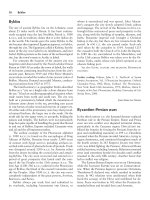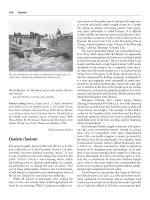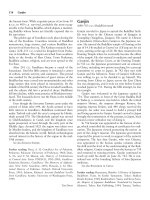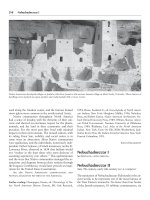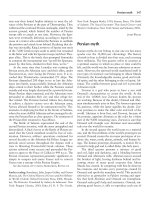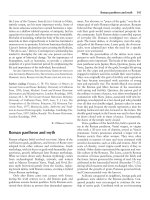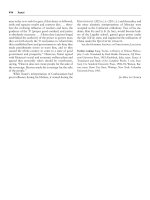Encyclopedia of world history (facts on file library of world history) 7 volume set ( PDFDrive ) 1449
Bạn đang xem bản rút gọn của tài liệu. Xem và tải ngay bản đầy đủ của tài liệu tại đây (65.15 KB, 1 trang )
of the Invisible World (1693) was the New England
leadership’s official account of the Salem witch hunt.
He later interpreted some misfortunes that had befallen his family as God’s punishment of him for not having spoken out against the persecutions, but in public
he defended the actions of the magistrates. He was the
principal target of the Boston merchant Robert Calef’s
anti–witch hunting work More Wonders of the Invisible World (1700).
Cotton Mather survived the attacks of Calef and
others to remain Boston’s leading minister until his
death. He also reached beyond Boston to participate
in the debate over the implications of the new science
for Protestant Christianity taking place all over the
British world. Mather prided himself on being a fellow
of the Royal Society, the leading scientific society in
England, and communicated stories of oddities from
America to be included in its journal, Philosophical
Transactions.
One of Mather’s most important 18th century
works was Magnalia Christi Americana (1702), an
attempt at a providential synthesis of New England
history. Mather had begun the Magnalia in 1693 and
regarded it as his most important work. It covers the
origin of the New England colonies, the lives of its
governors and ministers, the story of Harvard College, remarkable events, and the colonies’s conflicts
internal and external.
Other major works from this part of Cotton’s
career include an unpublished medical compendium,
The Angel of Bethesda, and a book integrating early
18th century science and Puritan theology, The Christian Philosopher (1721). After Increase’s death, Cotton
published a biography of his father, Parentator (1724).
He also wrote many manuscript volumes of biblical
commentaries that were never published.
Cotton Mather, who lost wives and children to
smallpox, was the leading American champion of
inoculating people with a weak form of smallpox to
prevent their catching the disease later, an idea introduced to the English-speaking world in the early 18th
century. His knowledge of inoculation came primarily from reports in Philosophical Transactions and
accounts of African practices from his slave Onesimus.
Mather began openly promoting inoculation during a
smallpox epidemic in Boston in 1721.
He was personally attacked by those who thought
the procedure too risky. A bomb was actually tossed
into his house, but fortunately it failed to explode.
(Mather believed that the devil had taken possession
of those who opposed inoculation in order to attack
Medici family
239
him personally.) The smallpox campaign contributed
to Mather’s loss of influence in his last years.
See also Bible traditions; Calvin, John; epidemics in
the Americas.
Further reading: Hall, Michael G. The Last American Puritan: The Life of Increase Mather, 1639–1723. Middletown,
CT: Wesleyan University Press, 1988; Levin, David. Cotton
Mather: The Young Life of the Lord’s Remembrancer, 1663–
1703. Cambridge, MA: Harvard University Press, 1978; Middlekauf, Robert. The Mathers: Three Generations of Puritan
Intellectuals. Oxford: Oxford University Press, 1971; Silverman, Kenneth. The Life and Times of Cotton Mather. New
York: Harper and Row, 1984; Winship, Michael P. Seers of
God: Puritan Providentialism in the Restoration and Early
Enlightenment. Baltimore, MD: Johns Hopkins University
Press, 1996.
William E. Burns
Medici family
Salvestro de’ Medici, in the 14th century, was the first
of the family to make a bid for political power when
he led the revolt of the the small artisan class against
the nobility who governed the city. Salvestro overbid
his hand and became virtually a dictator in Florence,
causing all Florentines to unite and banish him from
the city in 1382. After Salvestro’s ejection from the city,
Giovanni di Bicci de’ Medici was able to restore both
the family’s wealth and its social standing in the community, important in the tightly knit fabric of the Italian city-states of the period. Giovanni made the Medici
the richest family in Italy, perhaps in Europe.
The Medici family became paramount in Florence
due to Giovanni’s son, Cosimo the First, or Cosimo
the Elder (Cosimo il Vecchio). However, at first, taking advantage of the death of Giovanni in 1429, the
powerful Albizzi family banished Cosimo from Florence in 1433. Cosimo’s exile was brief. The Florentines
brought Cosimo back in triumph to the city the next
year. He respected the republican character of the city
and did not make an obvious grab for power. However,
through his great wealth and personal ability, Cosimo
nevertheless became the first citizen of Florence and the
virtual ruler of the city.
Indeed, Muslim pirates, or corsairs, had been
preying on Venetian shipping for some time. However, boasting one of the largest navies in Renaissance
Europe, the Venetians at this time were a great power

